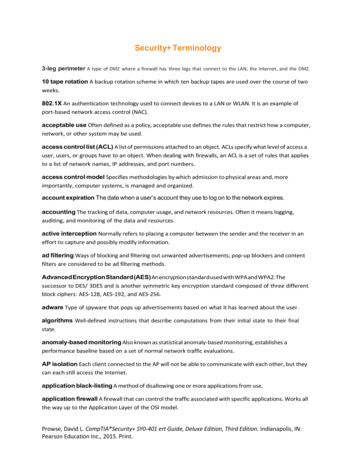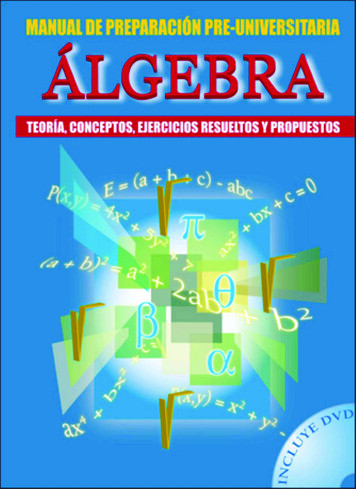
Transcription
Algebra 1 Review for Algebra 2Table of ContentsSection1. GoTo2. GoTo3. GoTo4. GoToGoToGoToGoTo5.6.GoToGotoTopicSolving EquationsStraight-lined GraphsFactoring Quadratic TrinomialsFactoring al NotationRadical Expressions and EquationsPage128101112151719Summer ReadingFor each student taking Algebra 2 next Fall at Jesuit High School, itis recommended that they read this material and complete all of thePractice Problems at the end of each section.
Jesuit High SchoolAlgebra 1 ReviewAlgebra 1 Review for Algebra 21.Solving EquationsThis section requires that you solve an equation for a specific variable.A.Procedure1)2)3)4)5)B.Clear the equation of fractions by multiplying all the terms by the LowestCommon Denominator (LCD).Isolate all terms that contain the variable you are solving for.Combine like terms.Factor, if necessary.Divide to solve for the variable you are looking for.Examples1)Example 1: For the equation d rt, solve for t:d rtd rt r rd tr2)Factor the right sideDivide both sides by (r s)r s 1 on the right-hand side, leaving xr sExample 3: For the equation p 2l 2w, solve for l :p 2l 2wp 2w 2lp 2 w 2l 22p 2w l2Rev 3/20/06r 1 on the right-hand side, leaving trExample 2: For the equation S rx sx, solve for x:S rx sxS x(r s)Sx(r s ) r sr sS xr s3)Divide both sides by rSubtract 2w from both sidesDivide both sides by 22 1 on the right-hand side, leaving l2Page 1 of 21Return to Table of Contents
Jesuit High SchoolC.2.Algebra 1 ReviewPractice Problems1)Solve for t :I Pr t3)Solve for h :1A bh25)Solve for π:7)9)p q22)Solve for p:Q 4)Solve for t :A at btA πr 26)Solve for a:S Solve for l :p 2(l w)8)Solve for h:V lwhSolve for n:a 180(n 2)n10) Solve for R :1 2at2C KRrR rStraight Line GraphsThis review of straight line graphs will refresh your Algebra 1 skills on this particular areaand assist you in meeting the challenges of a variety of new topics that you will encounterin Algebra 2.A.Slope-Intercept Form of an Equation: y mx b1)Example 1. Graph y -2X 1a) Create a table of ordered pairs:x012y1-1-3b) Plot points:y(x,y)(0,1)(1,-1)(-1,3)(2,-3)xRev 3/20/06Page 2 of 21Return to Table of Contents
Jesuit High School2)Algebra 1 ReviewExample 2. Graph a) y x, b) y 2x, c) y 4x on the same set of )(-1,-4)(0,0)(1,4)(2,8)Note that the bigger thenumber in front of the x(the coefficient of x), thesteeper the graph. Thenumber in front of x tellsus the slope of the graph.(x,y)(-1,5)(0,3)(1,1)(2,-1)yxbaRev 3/20/06y-4048Example 3. Graph a) y -2x, b) y -2x 3, c) y -2x 3 on the same setof ,-1)(1,-3)(2,-5)Note that all these lines areparallel as they have thesame slope. They cross atdifferent points on the yaxis. When a straight line isin the form y mx b, thenthe “m” stands for the slopeand the “b” stands for the yintercept.Note also that when the slope is negative, the lines go down to the right(decreases), and when the slope is positive, the lines go up to the right(increases).Page 3 of 21Return to Table of Contents
Jesuit High School5)Algebra 1 ReviewDefinition of slope.SLOPE rise change in y y 2 y1 mrun change in x x2 x1Positive slope:Negative slope:yx2 – x1(x1, y1)(x2, y2)y 2 – y1(x1, y1)6)y2 – y1xx(x2, y2)x2 – x1Example 4. Find slope and y-intercept of the following and graph each equation.a) y 3x – 1ySlope 3y-intercept -13rise 3 run 1x1b) 3y 2x 6y3y -2x 62y x 23Slope -2/3y-intercept 2rise 2 run3Rev 3/20/062-3xPage 4 of 21Return to Table of Contents
Jesuit High SchoolB.Algebra 1 ReviewThe Point-Slope Equationy y1 m( x x1 )1)where m slope and( x1 , y1 ) is a point on the line.Example 1. Write the point-slope equation of a line with slope -1/2 containingthe point (3, -1):y y1 m( x x1 )1y 1 ( x 3)22)Example 2. Write the slope-intercept equation of a line with slope 3 containingthe point (-2, 5):y y1 m( x x1 )y 5 3( x 2)y 5 3x 6y 3 x 113)Example 3. Graph the line with slope 2 that passes through ( 2, -1):y124)(2, -1)Example 4. Find the slope of the line containing the points (-2, 1) and (3, -4):Slope 5)xy 2 y1 4 1 5 1 x2 x1 3 ( 2) 5Example 5. Find the slope of the line y 2.In Slope-Intercept format, y 0x 2. Therefore, m 0, or the slope is zero. Aline with zero slope is always horizontal.Rev 3/20/06Page 5 of 21Return to Table of Contents
Jesuit High SchoolAlgebra 1 Reviewyy 2x6)Example 6. Find the slope of line x -2.For any value of y, x will always equal -2. Therefore, the line must always bevertical. The change in x is zero, making the slope undefined since we cannotdivide a number by zero (Slope equation).yx -2xC.Graphing Using Intercepts1)Use this method when the equation is in the general form: Ax By C2)General steps:a)b)c)d)3)Find the x-intercept by setting y 0Find the y-intercept by setting x 0Plot the x-intercept and y-intercept on the axesDraw the line by connecting the two pointsExample. Plot the equation 4x 5y 20.a)b)c)When x 0, 5y 20, therefore y 4. The y- intercept is (0, 4)When y 0, 4x 20, therefore x 5. The x-intercept is (5, 0)Plot these points and join them together with a straight line.y(0, 4)x(5, 0)Rev 3/20/06Page 6 of 21Return to Table of Contents
Jesuit High SchoolD.Perpendicular Lines1)2)3)4)5)6)E.Algebra 1 ReviewTwo lines are perpendicular when their slopes are the negative reciprocal of oneanother.If two negative reciprocals are multiplied by each other, the result is -1.The reciprocal of x is 1/x and the negative reciprocal of x is -1/x.So if one slope is m, then the other slope is -1/m.Example: if the slopes of two lines are -2/3 & 3/2, they are perpendicular.Example: The slope of a line perpendicular to a line with slope 4 is -1/4.Practice Problems1)For the following, create a table of ordered pairs and plot the points. Drawstraight lines on the same axes:a) y 3xb) y 3x - 2c) y 3x 1What do you notice about these lines?2)For the following, create a table of ordered pairs and plot the points. Drawstraight lines on the same axes:a) y -xb) y -x – 1c) y -x 3What do you notice about these lines?3)Find the slope and y-intercept, then graph the following using the slope andintercept:1a) y 2x 4b) y -4x – 1c) y x 23Rewrite the following in slope-intercept form and find the slope and y-intercept:a) 2x 3y 9b) 2y – 5x 8c) 6y – x 54)5)6)Write slope-intercept form of the line with given slope m and a point on the line:1c) m -3; (-4, -6)a) m 3; (4, 1)b) m ; (2, -4)2Graph the following straight lines on the same set of axes:a) m 2; point on line (2, -5)b) m 1; point on line (-1, -2)2What do you notice about these lines?7)Find the slope of the line containing the following points:a) (3, 1) & (-2, 4)(b) (-4,-5) & (2, 1)c) (-3, -1) & (7, -1)8)Graph each line and state the slope of each line:a) y -5b) x 2c) y 3Rev 3/20/06Page 7 of 21d) x 0Return to Table of Contents
Jesuit High School9)Algebra 1 ReviewGraph the following given two points on the line and find the slope of each line.a) (1, -4) & (-2, 3)b) (2, 3) & (2, -3)c) (5, -2) & (-1, -1)10) Graph the following using the x and y intercepts:a) 2x 7y 14b) 5x – 3y 15c) 2x – 3y 411) Write slope-intercept form of line parallel to given line & through given point.a) y 2x 4; (3,1)b) y -3x -1; (-2, 3)c) y 0.5x -10; (4, 6)12) Write slope-intercept form of line perpendicular to given line and through agiven point.a) y 2x - 3; (2,4)b) y -3x -4; (-6, 3)c) y 0.5x -8; (1, 3)3.Factoring Quadratic Trinomials (also known as the “Bottoms Up” method)When you have a trinomial whose coefficient is other than “1” use the following method tofactor:A.Example 11) 3x 2 10 x 82)x 2 10 x 243) ( x 12)( x 2)1224) ( x )( x )3325) ( x 4)( x )36) ( x 4)(3x 2)7)B.Original equationMultiply the constant by the leading coefficient.Factor the trinomial as if the leading coefficient were “1”Divide the constant by the original coefficientSimplify each fractionMove any denominator for each binomial into the leadcoefficient position.Check the resulting factors by using FOIL.Example 21) 6 y 2 19 y 102)3)4)5)6)Rev 3/20/06Check by using FOIL:(2 y 5)(3 y 2)y 2 19 y 60( y 15)( y 4)154( y )( y )6652( y )( y )23(2 y 5)(3 y 2)6 y 2 4 y 15 y 106 y 2 19 y 10 Checks!Page 8 of 21Return to Table of Contents
Jesuit High SchoolC.D.E.Example 31) 4 x 2 13x 10x 2 13 x 402)3) ( x 8)( x 5)854) ( x )( x )4455) ( x 2)( x )46) ( x 2)(4 x 5)Don’t forget to checkExample 421) 3 35a 12a22) (12a 35a 3)23) (a 35a 36)4) (a 36)(a 1)361 (a )(a )12125) (a 3)(12a 1) or6)Example 51) 6 x3 15 x x 22)x(6 x 2 x 15)3)x( x 2 x 90)4)x( x 10)( x 9)1095)x( x )( x )66536)x( x )( x )327)4.Algebra 1 ReviewFactor out -1Don’t forget to check(3 a )(12a 1)Correctdescending orderCheck!x(3x 5)(2 x 3)Factoring PolynomialsA.OverviewFactoring is the opposite procedure of distributing. Factoring a polynomial is the sameas finding an equivalent expression expressed as a product.Example: 2 x 42( x 2)Rev 3/20/06BinomialFactored (expressed as a product)Page 9 of 21Return to Table of Contents
Jesuit High SchoolB.Algebra 1 ReviewGeneral ProcedureFactoring polynomials can follow a set pattern. The diagram below is a helpfulschematic to follow when factoring. Always start any factoring problem with thequestion: “Are there common factors in each term?”x 2 10 x 25YESFactor out common termBINOMIALPOLYNOMIALNOIf NO, then identify the type of polynomial.In this case, you have a trinomial.TRINOMIALIf it’s a binomial, askif Difference of Squares?If it’s a trinomial, ask the followingthree questions:If it’s a polynomial with 4or more terms. . . Group ingroups of TWO or THREE1. Is the expression a PERFECT SQUARE TRINOMIAL?2. Is the expression a TRINOMIAL with a leading coefficient of 1?3. Is the expression a TRINOMIAL with a leading coefficient greater than 1?In this case you have a perfect square trinomial1.2.C.x 2 10 x 25( x 5)( x 5)“What two factors of 25 add up to 10?”Answer: “ 5 and 5”Binomials1)Rev 3/20/06Overviewa)Binomials have two terms. When factoring binomials, always start by asking“Are there any common factors in each term?” If so, then factor out thecommon term and start over with the resulting binomial. Look for aDifference of Squares when you start over (explained below).b)Example:4 x 2 164( x 2 4)4( x 2)( x 2)Page 10 of 21The resulting binomial is adifference of squares and canbe factored furtherReturn to Table of Contents
Jesuit High School2)Algebra 1 ReviewDifference of Squaresa)b)Once you have factored out a common term, the other characteristic tolook for is a Difference of Squares. A Difference of Squares is recognizedexactly according to its name: A DIFFERENCE (subtraction) of twoSQUARES.x2 and 25 are both squaresExample: Difference of Squaresx 2 25c)Example: NOT a Difference of Squaresd)If the problem is a Difference of Squares, then write out two parentheseswith opposite signs and the square root of each perfect square.e)Example:x 2 25Not a difference of squaresbecause there is a signDifference of Squares because x 2 is a squarex 2 25and 25 is a square with a minus sign betweenthem.( x 5)( x 5) Use FOIL to check3)Practice Problems – Factor each of the following binomials. Make sure you followthe procedure outlined above. Write out each step. Remember how to multiplydecimals and fractions.a)c)e)x 2 492 x 4 50 x 29x2 y 2 z 22b) 4 x 2 1d) x 2 y 2f) .25a 4 .36b 4h) x 8 y 82 x y g) 2 2 HINT: Make sure you keep factoring any resulting difference of squaresD.Trinomials1)DefinitionsLinear TermQuadratic termConstantx 10 x 252Rev 3/20/06Page 11 of 21Return to Table of Contents
Jesuit High School2)Algebra 1 ReviewOverviewa)Trinomials have three terms. Start factoring trinomials the same way youfactor binomials. Ask: “Are there any common factors in all three terms? Ifyes, factor out the common term. If no, then ask yourself one of thefollowing three questions: b)3)Is the trinomial a PERFECT SQUARE trinomial?Does the trinomial have a leading coefficient of 1?Does the trinomial have a leading coefficient greater than 1?Each of these questions will lead you to a different method of factoring.Is the Trinomial a Perfect Square Trinomial?a)A perfect square trinomial such as x 2 10 x 25 has a constant which is aperfect square and a linear term that is a sum of the perfect square factors.b)Example 1:x 2 10 x 25( x 5)( x 5)c)4)Rev 3/20/06Example 2x 2 12 x 36( x 6)( x 6)Ask yourself: “What factors of 25 add up to thecoefficient of the linear term? (In this case, 10)Q. “What factors of 36 add up to -12?”A. (-6)(-6) 36 and (-6) (-6) -12Does the Trinomial have a leading coefficient of “1” ?a)Use the same procedure as a perfect square trinomial. Ask the samequestion:b)Example:x 2 7 x 10( x 5)( x 2)Q. “What factors of 10 add up to -7?”A. (-2)(-5) 10 and (-2) (-5) -7Page 12 of 21Return to Table of Contents
Jesuit High School5)Algebra 1 ReviewDoes the Trinomial have a leading coefficient greater than “1” ?When you have a trinomial whose coefficient is other than “1” use the “bottomsup” method to factor:a)Example 1:3x 2 10 x 8x 10 x 24( x 12)( x 2)2122( x )( x )332( x 4)( x )3( x 4)(3 x 2)b)Example 2:Multiply the constant by the leading coefficient.Factor as if the leading coefficient were “1”Divide the constant by the original coefficientSimplify each fractionMove any denominator for each binomial into the leadcoefficient position.Check the resulting factors by using FOIL.6 y 2 19 y 10y 2 19 y 60( y 15)( y 4)154( y )( y )6652( y )( y )23(2 y 5)(3 y 2)Check by using FOIL(2 y 5)(3 y 2)6 y 2 4 y 15 y 106 y 2 19 y 10c)Example 3:Checks!4 x 2 13x 10x 2 13x 40( x 8)( x 5)85( x )( x )445( x 2)( x )4( x 2)(4 x 5)Don’t forget to CHECKRev 3/20/06Page 13 of 21Return to Table of Contents
Jesuit High SchoolAlgebra 1 Reviewd)e)6)Example 4:Example 5:3 35a 12a 2 (12a 2 35a 3) (a 2 35a 36) (a 36)(a 1)361 (a )(a )1212 (a 3)(12a 1) orFactor out -1(3 a)(12a 1)Correct descendingorder6 x3 15 x x 2x(6 x 2 x 15)x( x 2 x 90)x( x 10)( x 9)109x( x )( x )6653x( x )( x )32x(3x 5)(2 x 3)CHECKPractice ProblemsFactor each of the following trinomials according to the procedure above.Highlight which problems are perfect square trinomials. Also notice whichtrinomials use the “bottoms up” method. Write out each step. Box your answer.Try to recognize a pattern in analyzing the problems.x 2 10 x 256m 2 23m 206z 2 5z 612 x 2 23x 10x3 x 2 30 x2 x 2 34 x 220m) ( x 1) 2 2( x 1) 1HINT:Treat the (x 1) as a “single”variable; try substituting “y” for“x 1” and solvex 2 7 x 102 x 2 10 x 8a 4 5a 2 b 6b 2( xy ) 2 4 xy 43x 2 10 x 8x 2 2 xy 48 y 2x 6 2 x3 15HINT: Replace62x with υ and x3 with υ 1 so you canrewrite the problem as υ 2 2υ 15 .After factoring, replace the υ with x 3and rewrite.2o) 16 y 49 56 y Hint: Correct descending order?a)c)e)g)i)k)Rev 3/20/06Page 14 of 21b)d)f)h)j)l)n)Return to Table of Contents
Jesuit High SchoolE.Algebra 1 ReviewPolynomialsPolynomials of this type have four (or more) terms. When factoring these types ofpolynomials, group the polynomial using groups of 2 terms and 2 terms, or 3 termsand 1 term. Certain characteristics will lead you to group correctly. The examplesbelow illustrate this idea.1)Groups of 2 terms and 2 termsa)Example 1:x 2 xy 2 x 2 y(x2Since the terms are all connected by additionsigns, you may move terms in any order. In thiscase, group the first two and last two terms.From each new binomial, factor out what iscommon in each term.Notice that the resulting factor is the same.The resulting sum is really just a large binomial.Factor out the (x y) and add the leftoverfactors.) xy (2 x 2 y )x( x y ) 2( x y )( x 2)( x y )b)Example 2:x2 y2 x yGroup the first two terms and the last twoterms.Remember to change the sign in front of the last“y” because when you distribute the negativesign, the last “y” becomes positive.Factor out the (x - y) and subtract the resultingfactors.( x 2 y 2 ) ( x y)( x y )( x y ) 1( x y )( x y )( x y 1)c)d)Rev 3/20/06Example 3:3x 3 2 x 2(3x 3) (2 x 2)3( x 1) 2( x 1)( x 1)(3 2) or 5( x 1)Example 4:a 3 ab 2 2a 2 2b 2(a 3 ab 2 ) (2a 2 2b 2 )a (a 2 b 2 ) 2(a 2 b 2 )(a 2 b 2 )(a 2)(a b)(a b)(a 2)Group the first two and the last two terms.Factor.Factor (x - 1) and add the resulting terms.Group the first two and the last two terms.Change the sign in front of the last 2b 2Factor out common terms.Note that a 2 b 2 is a difference of squares.Factor.Page 15 of 21Return to Table of Contents
Jesuit High School2)Algebra 1 ReviewGroups of Three Terms and One TermInstead of grouping a four-term polynomial by groups of two, sometimes youmust group the first three terms and the last term. You group the first threeterms if you notice the following characteristics: a)Your polynomial contains THREE perfect squares x 2 xy y 2 1 . Remember“1” is a perfect squareThe last perfect square is subtracted.The “middle” term is the product of the two factors on either side of it.Example 1:x 2 xy y 2 1( x 2 xy y 2 ) 1( x y)2 1[( x y ) 1][( x y ) 1]( x y 1)( x y 1)b)Example 2:x 2 10 x 25 y 2( x 2 10 x 25) y 2( x 5) 2 y 2[( x 5) y ][( x 5) y ]( x 5 y )( x 5 y )3)Group first three terms and last term.The first three terms are a perfect squaretrinomial. Factor.After you factor, you have a Difference ofSquares binomial.Polynomials are all “additions,” erase theparentheses.Check by FOILThe first three terms are a perfect squaretrinomial. The last term is a subtracted perfectsquare. Group “three” and “one.”Factor the perfect square trinomial.Factor the binomial.Drop the parentheses.Check by FOILPractice ProblemsFactor each of the following polynomials. Look for the characteristics whichmake each one a grouping of “2 and 2” or a grouping of “3 and 1.” Show everystep according to the examples above. Label each step. Box your answer.Rev 3/20/06a)xy xz y 2 yzb)x3 3x 2 4 x 12c)x2 6 x 9 y 2d)x 2 y 2 8 y 25e)x 2 12 x 36 49Page 16 of 21Return to Table of Contents
Jesuit High School5.Algebra 1 ReviewExponential NotationA.B.Definitions and rules1)Exponential notation is xy, where x is the base and y is the exponent.2)Example: 105 – 10 is the base and 5 is the exponent, and the expression isequivalent to 10 x 10 x 10 x 10 x 10, or 10 five times.3)Rules for order of operations:a) Calculate within the innermost grouping symbolb) Simplify all exponential expressionsc) Perform all multiplication and division, working from left to rightd) Perform all addition and subtraction, working from left to right4)Examples:22a) (3 4) (12) 144b) 3 4 2 3 16 48Multiplying Powers with like bases1)Product rule: for any number a and any positive integers m and n,a m a n a m n . Examples:a)b)c)2)b 4 b3 b7x 2 x 9 x11(r s )7 (r s )6 (r s )13amm nQuotient rule: for any number a and any positive integers m and n, n aaExamples:x8a) x 8 2 x 62x79b) 7 9 4 7 547p5q7 p5 q7 2 p 5 2 q 7 1 p 3 q 6c)2p qpqRev 3/20/06Page 17 of 21Return to Table of Contents
Jesuit High SchoolC.D.E.F.Algebra 1 ReviewZero as an Exponent1)The quotient rule can be used to determine wha
3. Factoring Quadratic Trinomials (also known as the “Bottoms Up” method) When you have a trinomial whose coefficient is other than “1” use the following method to factor: A. Example 1 1) 3x2 10x 8 Original equation 2) x2










